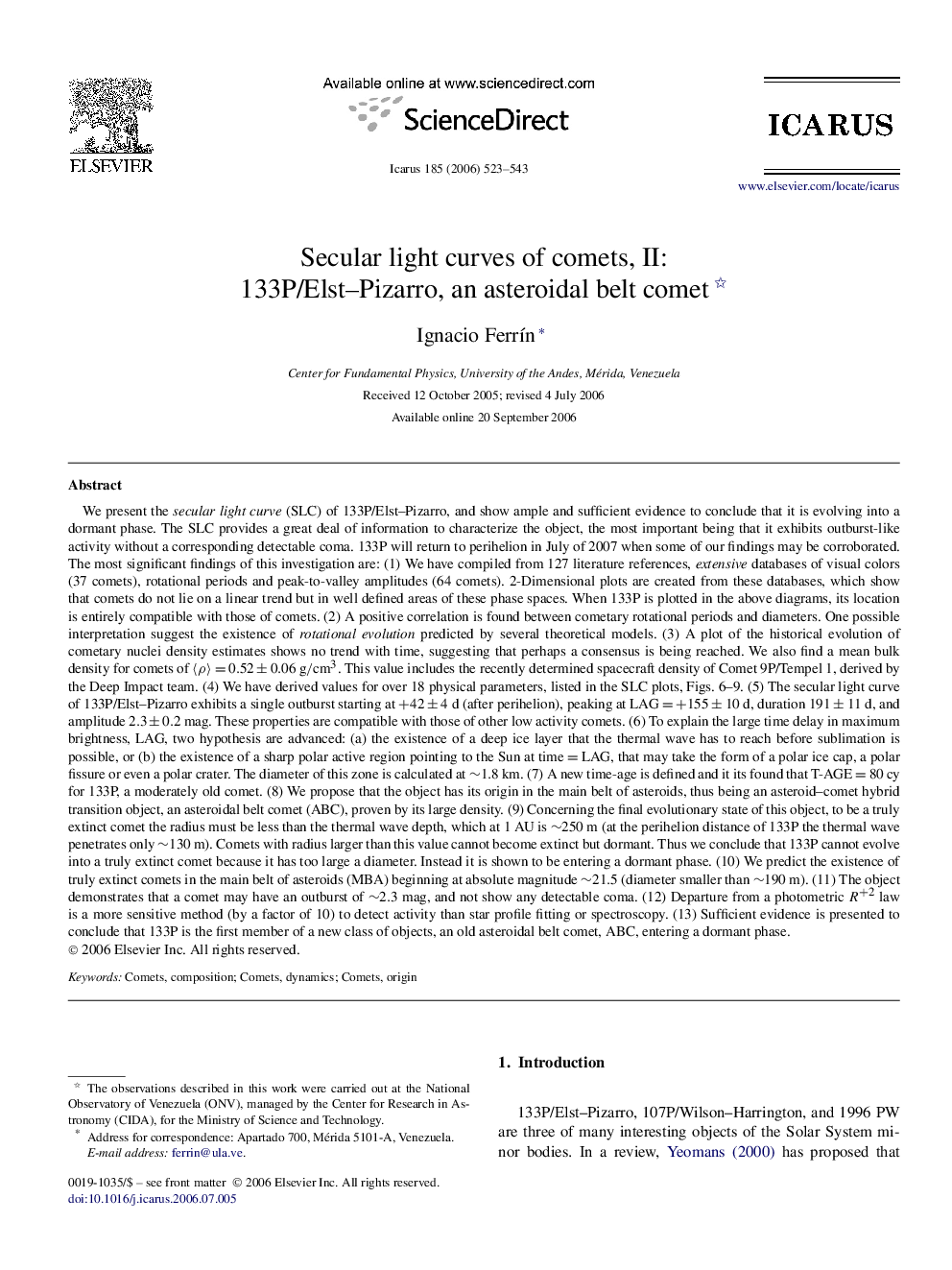| کد مقاله | کد نشریه | سال انتشار | مقاله انگلیسی | نسخه تمام متن |
|---|---|---|---|---|
| 1775513 | 1021196 | 2006 | 21 صفحه PDF | دانلود رایگان |

We present the secular light curve (SLC) of 133P/Elst–Pizarro, and show ample and sufficient evidence to conclude that it is evolving into a dormant phase. The SLC provides a great deal of information to characterize the object, the most important being that it exhibits outburst-like activity without a corresponding detectable coma. 133P will return to perihelion in July of 2007 when some of our findings may be corroborated. The most significant findings of this investigation are: (1) We have compiled from 127 literature references, extensive databases of visual colors (37 comets), rotational periods and peak-to-valley amplitudes (64 comets). 2-Dimensional plots are created from these databases, which show that comets do not lie on a linear trend but in well defined areas of these phase spaces. When 133P is plotted in the above diagrams, its location is entirely compatible with those of comets. (2) A positive correlation is found between cometary rotational periods and diameters. One possible interpretation suggest the existence of rotational evolution predicted by several theoretical models. (3) A plot of the historical evolution of cometary nuclei density estimates shows no trend with time, suggesting that perhaps a consensus is being reached. We also find a mean bulk density for comets of 〈ρ〉=0.52±0.06 g/cm3〈ρ〉=0.52±0.06 g/cm3. This value includes the recently determined spacecraft density of Comet 9P/Tempel 1, derived by the Deep Impact team. (4) We have derived values for over 18 physical parameters, listed in the SLC plots, Figs. 6–9. (5) The secular light curve of 133P/Elst–Pizarro exhibits a single outburst starting at +42±4 d+42±4 d (after perihelion), peaking at LAG=+155±10 dLAG=+155±10 d, duration 191±11 d191±11 d, and amplitude 2.3±0.2 mag2.3±0.2 mag. These properties are compatible with those of other low activity comets. (6) To explain the large time delay in maximum brightness, LAG, two hypothesis are advanced: (a) the existence of a deep ice layer that the thermal wave has to reach before sublimation is possible, or (b) the existence of a sharp polar active region pointing to the Sun at time = LAG, that may take the form of a polar ice cap, a polar fissure or even a polar crater. The diameter of this zone is calculated at ∼1.8 km. (7) A new time-age is defined and it its found that T-AGE = 80 cy for 133P, a moderately old comet. (8) We propose that the object has its origin in the main belt of asteroids, thus being an asteroid–comet hybrid transition object, an asteroidal belt comet (ABC), proven by its large density. (9) Concerning the final evolutionary state of this object, to be a truly extinct comet the radius must be less than the thermal wave depth, which at 1 AU is ∼250 m (at the perihelion distance of 133P the thermal wave penetrates only ∼130 m). Comets with radius larger than this value cannot become extinct but dormant. Thus we conclude that 133P cannot evolve into a truly extinct comet because it has too large a diameter. Instead it is shown to be entering a dormant phase. (10) We predict the existence of truly extinct comets in the main belt of asteroids (MBA) beginning at absolute magnitude ∼21.5 (diameter smaller than ∼190 m). (11) The object demonstrates that a comet may have an outburst of ∼2.3 mag, and not show any detectable coma. (12) Departure from a photometric R+2R+2 law is a more sensitive method (by a factor of 10) to detect activity than star profile fitting or spectroscopy. (13) Sufficient evidence is presented to conclude that 133P is the first member of a new class of objects, an old asteroidal belt comet, ABC, entering a dormant phase.
Journal: Icarus - Volume 185, Issue 2, December 2006, Pages 523–543